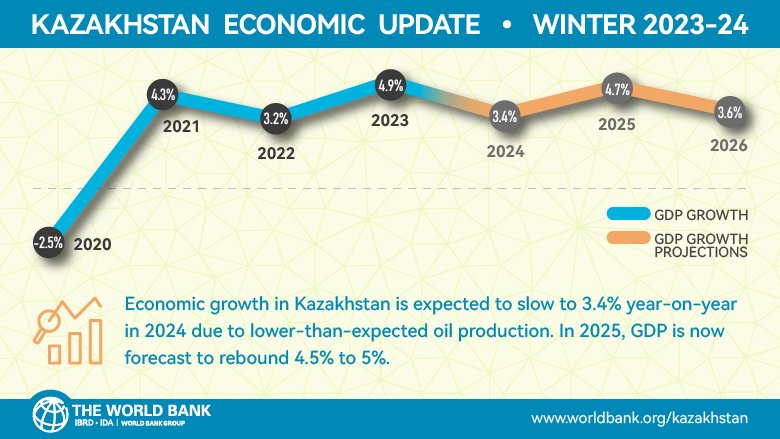Kazakhstan’s economic forecast for the next two years is steady growth. After rebounding from the adverse impacts of Russia’s invasion of Ukraine in 2023, growth is expected to slow to 3.4% year-on-year in 2024 due to lower-than-expected oil production.
Real GDP is forecast to grow by 4.5-5% in 2025 as the expansion of production capacity in existing oilfields is set to boost exports and spur growth of the petrochemical industry in 2025 and beyond. Investment in mining and manufacturing is anticipated to be stable. Household spending growth is expected to strengthen in 2024 as inflation subsides and financial conditions ease.
Elevated inflation is expected to fall, but to remain above the National Bank of Kazakhstan’s (NBK) target in 2024 and 2025. Inflationary pressures started to ease in 2023, falling to 9.8% in December 2023, following monetary tightening. Achieving the NBK’s inflation target of 5% could be possible provided there is no premature monetary loosening alongside implementation of fiscal consolidation plans. Continued measures to remove distortive subsidized interest rate policies will improve the effectiveness of the transmission of monetary policy.
The banking system remains resilient to external shocks, including the spillover effects of Russia’s invasion of Ukraine. The non-performing loan ratio stood at 3.2% in November 2023. Banks have maintained robust funding and ample liquid assets, exceeding regulatory thresholds, though there are signs of rising credit risks, which warrants continued surveillance and mitigation.
The current account is expected to remain in a deficit at 3.0% and 2.3% of GDP in 2024 and 2025, respectively. Higher demand for imports and falling export receipts against the backdrop of lower oil prices led to a current account deficit of about 3.3% of GDP in 2023. The NBK’s gross international reserves stood at seven months of import cover. The deficit is expected to persist in 2024 and decline steadily, while inward foreign direct investment (FDI) flows are projected to continue, largely destined to the mining sector.
The draft budget plan for 2024-26 moves towards fiscal consolidation. Budget stimulus measures, largely targeted to social welfare programs, resulted in an estimated consolidated budget deficit of 1.8% of GDP in 2023. The government is planning to gradually decrease the deficit in the medium term in line with the fiscal rule to preserve fiscal buffers. Government debt is sustainable, but debt servicing costs have been increasing, reflecting the reliance on domestic debt in a context of high domestic interest rates.
Downside Risks to Growth
Kazakhstan’s growth outlook faces several downside risks emanating from both domestic and external factors. Russia’s invasion of Ukraine and the resultant tensions in and near the Black Sea could lead to further disruption of Kazakh oil exports via the Caspian pipeline, which would have severe economic and fiscal repercussions given the importance of the hydrocarbons sector. Any major unscheduled maintenance in the oil fields as well as unexpected delay in the development of the Tengiz oil field might curtail production and dampen economic growth.
Unforeseen external pressures and volatility of the tenge could lead to higher inflation. Furthermore, given Kazakhstan’s economic ties with Russia, the risk of secondary sanctions continues to be a concern, which would dent confidence, deter FDI, and undermine growth.
Special Focus: Reforms for Lasting Prosperity
The special section of this Economic Update examines Kazakhstan’s growth challenges and the underlying structural weaknesses and proposes reform priorities for long-term development. Between 2018-22, average GDP per capita growth was 1%, well below the average of 3.3% for upper middle-income countries. Delivering a better quality of life and higher incomes for citizens in a global context that is committed to decarbonization requires rethinking reform priorities.

